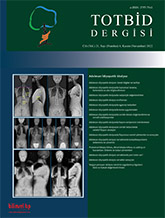
Early diagnosis of adolescent idiopathic scoliosis may slow down the progression of the curvature before the skeletal maturity is reached and early diagnosis also helps improving long-term outcomes. Adam`s forward bending test, scoliometric measurement and plumb line test are the most commonly used screening tests for diagnosis. These tests are very useful, but are not diagnostic alone because of the low sensitivity, specificity, and low positive predictive value. However, performing Adam forward bending test with plumb line test or using scoliometer with plumb line test together increases sensitivity and specificity. The current level of evidence in the literature that routine scoliosis screening is necessary is low to moderate. Almost, no country has a routine national scoliosis screening program. Although routine screening tests are not considered reasonable in many countries in terms of the balance of profit and loss account, it is very important to increase the awareness of scoliosis in the society for early diagnosis and treatment. Informing the family is very important in adolescent idiopathic scoliosis. Researchs have shown that the requirements of the families and the patients learning about adolescent idiopathic scoliosis are often not met. Unfortunately, information with poor quality negatively impacts the physician-patient dynamics, potentially causing stress and distrust. The most important rule of a successful treatment is to gain the trust of the family and the patient to increase their compliance with the treatment. Nevertheless, it is just possible if the patient and parents are informed accurately and adequately.